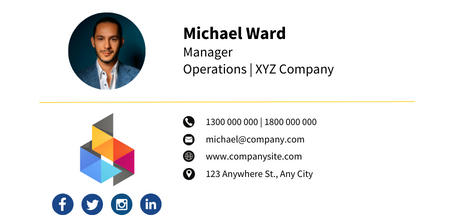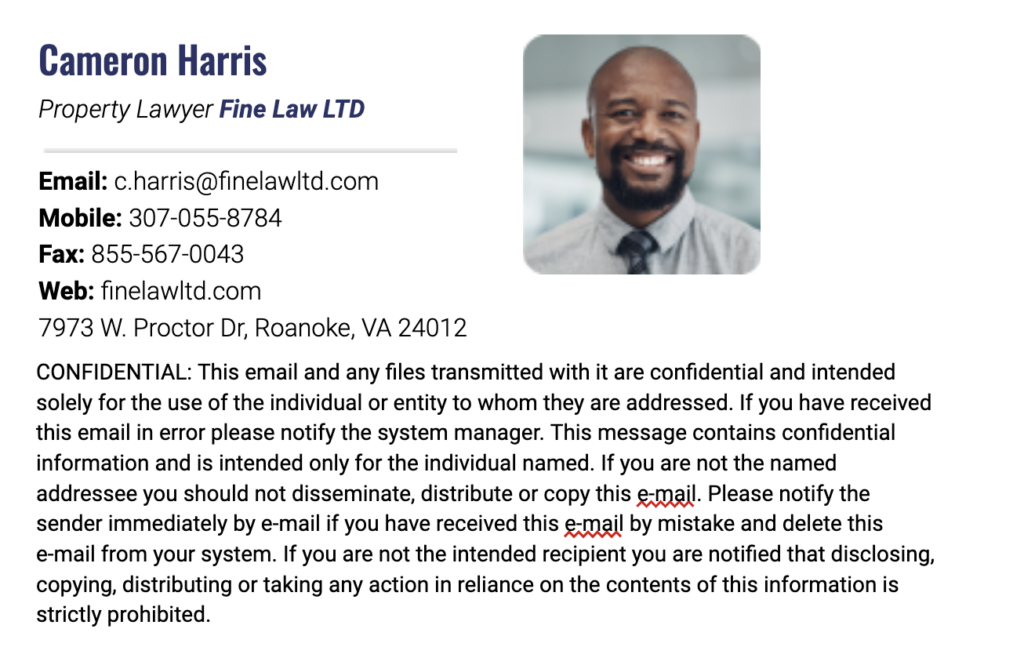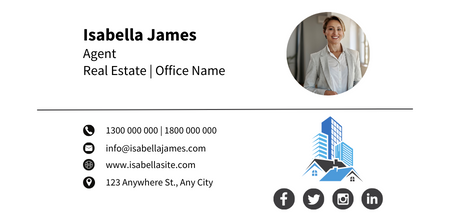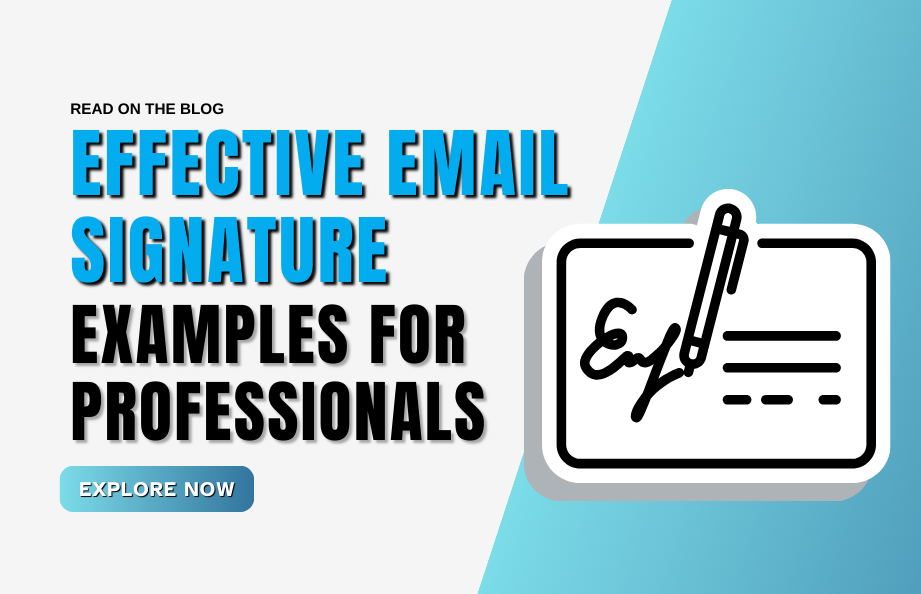As the world advances towards the digital age, email signatures have surpassed the need for traditional business cards. It serves as a digital handshake, seamlessly extending your brand identity. As indicated by Forbes, 82% of investors and consumers prefer endorsing brands with a robust and distinct identity. An email signature not only conveys your contact information but also reflects the identity of your brand and your professionalism. In this article, we will discuss tips for crafting proper email signatures with email signature examples to help you make a lasting impression on your recipients.
What is An Email Signature?
An email signature, also known as an email footer or email signature block, is a text block located at the end of an email. This block typically incorporates essential contact information and company branding, providing recipients with insights about yourself and your organization. Exploring email signature block examples can assist in determining the most suitable style to meet individual needs.
Why Email Signatures Are Important?
Professionalism
An email signature gives your email a professional touch. It conveys the message that you are committed to effective communication – leaving a positive impression of either yourself or your organization.
Credibility
The full name and contact information included in the email signature adds credibility to your email. It gives the recipient an idea about your identity and the email’s legitimacy.
Branding
Businesses use email signatures for their branding. They include their company logo, standardized fonts, and colors. This is a great way to represent your brand’s visual identity.
Legal Requirements
There may be legal requirements for some cases. The legal requirements are to add business registration details, disclaimers, or unsubscribe links for marketing links in email signatures.
What are the Key Elements of a Professional Email Signature?
Let’s delve into the key elements that make up an effective email signature.
1. Name: The name is the most prominent element in the email signature. You are supposed to use your full name.
2. Title and Company: Here, you need to clearly state your job title and the company you are representing to make it look more professional and credible.
3. Contact Details: This includes your email address, phone number, and physical office address if applicable.
4. Professional Photo: Adding a professional photo will personalize your communication and make a lasting impression on your recipients. But it is not necessary and depends on your business needs.
5. Social Media Links: If you have personal or professional websites or social media profiles, include them in the email signature.
6. Call-to-Action (CTA): Encourage engagement with a subtle call-to-action. This could be an invitation to schedule a call, visit your website, or explore a recent blog post.
7. Legal Requirements: Ensure compliance with legal regulations regarding business communication. Include any necessary disclaimers or legal information required in your industry or region.
8. Quotes or Tagline: Consider adding a brief and relevant quote or tagline. This can convey your values or mission and leave a positive and memorable impression.
When all these elements come together harmoniously, your email signature becomes a valuable asset in projecting a professional image and building trust with your recipients. Experiment with different combinations to find the perfect balance that suits your personal or company’s style. Remember, a thoughtfully crafted email signature is a small detail that can make a significant impact on how you or your brand is perceived in the professional arena.
How to Create and Add a Signature in Email?
If you find the process of creating and attaching an email signature daunting, explore our free Email Signature Maker. Effortlessly edit your information, choose from a variety of templates, and download the HTML file for seamless integration with your preferred email signature provider. Additionally, refer to our comprehensive guide on how to add the signature in email platforms such as Gmail, Yahoo, Hotmail, or any provider of your choice. Simplify the task of enhancing your professional email correspondence with our user-friendly tools and step-by-step guidance.
Best Email Signature Examples
Now, let’s explore a variety of email signature examples that cater to diverse needs, ranging from individuals to professionals in various business sectors. By examining these real-world examples, we can glean insights into the diverse ways individuals and businesses effectively utilize email signatures to enhance their personal and professional branding.
1. Corporate Email Signature Examples

An effective corporate email signature should strike a balance between professionalism, clarity, and brand consistency. It should feature a big company logo and a link to the corporate website with a formal layout. The above signature by Parrot Digital is a perfect example in which the tone is formal and conveys professionalism.
Create a free corporate email signature with our free email signature generator.

2. Professional Email Signature Examples

This signature focuses on creating a strong professional impression. It includes the individual’s name, job title, company name, contact details, and possibly a call-to-action like a link to schedule a meeting or visit the company’s product page. You can create a similar signature through our email signature generator.
A clean and well-designed email signature immediately signals professionalism. Ensure the layout is organized, the font is readable, and there’s an overall sense of visual harmony. Below is one more example of a professional email signature by Zapier.

3. Cool Email Signature

Vertical email signatures are at the top of the cool email signatures list and bring a cool and contemporary flair to professional communications. With a distinctive layout, they stand out in a sea of traditional horizontal signatures, capturing immediate attention. These signatures cater to the dynamic needs of digital communication, ensuring a seamless experience on various devices.
Overall, in a world where design trends evolve, choosing a vertical email signature reflects a forward-thinking approach to professional branding, making it a cool and innovative choice.
Let’s take a look at one more amazing horizontal email signature style at Canva which is refreshing to the eyes.

4. Business Email Signature Example

Striking a balance between style and substance, a business email signature in this format efficiently communicates essential details while projecting a polished and contemporary image. With concise contact information, social media links, and a subtle call-to-action, the signature becomes a powerful tool for engaging recipients.
5. Teacher Email Signature Example

The email signature for an academic professional is usually straightforward. With an emphasis on simplicity and relevance, it becomes a tool for effective communication and promotes a positive connection with students, parents, and colleagues.
6. Real Estate Agent Email Signature Example

A real estate agent’s email signature is designed to provide essential contact information and showcase property listings. It includes the agent’s name, title, company, phone number, and possibly links to featured property listings or the agent’s professional website. Meanwhile, it establishes the agent’s credibility by showcasing essential details, such as their affiliation with a reputable brokerage and relevant contact information.
7. Doctor or Healthcare Professional Email Signature Examples

Healthcare professional email signatures are essential for conveying crucial information such as the practitioner’s full name, title, medical institution, and contact details. These signatures not only establish a sense of professionalism and trust but also ensure compliance with industry standards. Including relevant credentials and affiliations enhances credibility, while a concise and well-designed format promotes clarity. Links to professional profiles, appointment scheduling, and essential disclaimers contribute to a seamless and informative communication experience for patients and colleagues.
8. Personal Email Signature Examples

A personal email signature holds significance as it offers a professional touch to your digital communication. It’s a virtual business card, that provides essential contact details like your full name, title, and additional information, conveying credibility and accessibility. A thoughtfully designed signature adds a touch of personality, making your emails memorable and leaving a positive impression just like this personal email signature example by Canva.

In crafting a personal email signature, keep it succinct yet informative. Include your name, relevant title, and a reliable contact method. Consider adding a personal flair, like a favourite quote or a link to your LinkedIn profile. Striking a balance between professionalism and a touch of individuality ensures an effective and personable email signature.
9. IT Professional Email Signature Examples

An IT specialist’s email signature emphasizes technical expertise. It includes their name, job title, company, and contact details. Additionally, it may feature certifications, a link to their GitHub profile, or other relevant technical achievements. Keep the design clean and modern, aligning with industry standards. For color selection, opt for a subdued palette such as shades of blue or grey, symbolizing trust, reliability, and the tech industry’s sophistication. A touch of color can be added to highlight key elements, but it’s crucial to maintain readability. Striking this balance ensures a visually appealing and informative email signature for an IT professional.
Check out this simple and sleek professional email signature example by Reverbico.

10. Freelancer Email Signature Example

A freelancer’s email signature often showcases their creativity. It includes their name, the title, a link to their portfolio, and possibly a visually appealing logo or a small design element. This type of signature reflects the designer’s artistic style.
Tips for Creating an Effective Email Signature
Following are 10 tips that you can implement to craft an effective email signature:
1. Keep it simple
A reader is unable to focus on a haphazard email signature. It can be distracting. Sticking to simple design elements and brief information will enable you to craft an effective email signature.
2. Be consistent
Email signatures should always be consistent across all professional correspondence. The consistency in email signatures reinforces brand identity.
3. Mobile Optimization
Most people check emails on their mobile phones. To avoid a bad impression, make your signature mobile-optimized.
4. Professional fonts
Given that professional fonts are a crucial part of the brand identity of businesses, they can make your email signature appear well-crafted and credible. You can choose Arial, Helvetica, or Calibri.
5. Legal Requirements
Some professions require legal disclaimers – that are included at the bottom. Some disclaimers aim to limit the sender’s liability. If your profession needs a legal requirement, it is important to include them.
6. Try an Email Signature Generator
There are multiple email signature generators online. You can also try an email signature generator that is user-friendly and customizable.
7. Test it
Testing is significant to craft an effective email signature. You can send test emails to different email clients using Outlook, Gmail, and Apple Mail to ensure the signature looks consistent and well-formatted.
8. Include a professional photo
A professional photo enables you to personalize your email signature and help recipients connect a face to the name.
9. Branding elements
If you represent a company, include branding elements such as the organization logo, official colors, and standardized fonts are essential. Brand consistency is the cornerstone of trust, reinforcing a cohesive and reliable identity across all touchpoints.
10. Prioritize key information
Recipients should only have the key information about your organization. Start with your name and title followed by your company name, email address, and phone number.
Conclusion
Email signatures can enhance the professionalism, credibility, and effectiveness of email communication, support branding, and meet legal requirements in some cases. The email signature is a valuable tool that can help you in professional communication – helping you make a strong and consistent impression on the recipients. It also serves as a silent brand ambassador, subtly promoting your business by incorporating essential details, social links, and calls-to-action, enhancing marketing reach and reinforcing brand identity with every communication.



